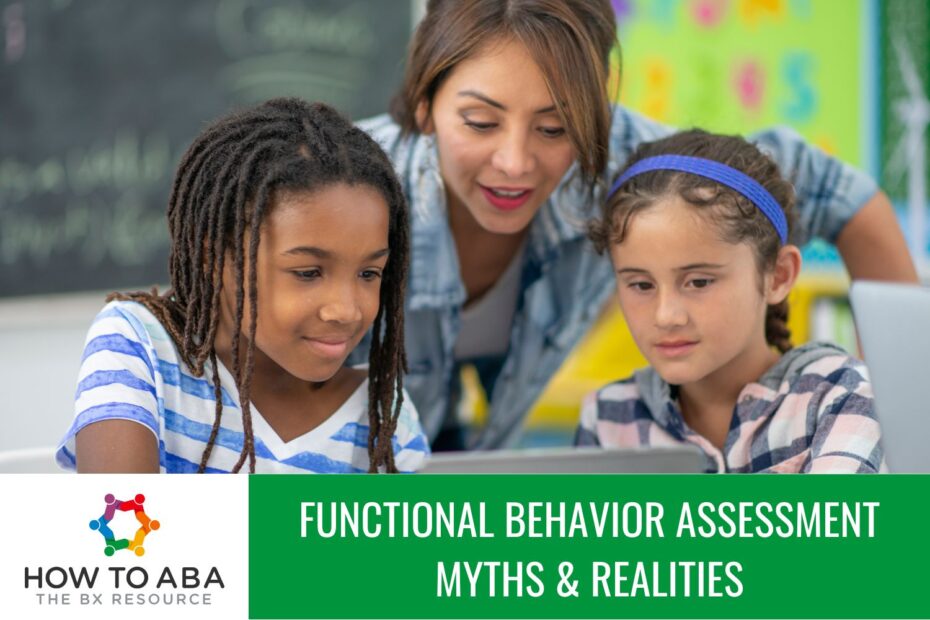Functional Behavior Assessments (FBAs) are often misunderstood. For families, educators, and professionals, the term can sometimes cause confusion or concern. Some people picture it as a way to control behavior, while others assume it’s only used in extreme cases. These myths create unnecessary barriers and can make parents feel uneasy about the process.
In reality, FBAs aren’t about “fixing” anyone. They are about uncovering the why behind behavior – what motivates a person, what they’re communicating, and how we can create environments where they feel safe, respected, and empowered to thrive.
An FBA is an act of collaboration, not control. It’s about dignity, consent, and choice. When approached ethically, FBAs open doors to learning and skill building while honoring each individual’s identity. Let’s take a closer look at some common myths and the truths that families, educators, and practitioners should know.
Myth #1: An FBA is about “fixing” behavior
Reality: An FBA is about understanding motivation.
One of the most common misconceptions about FBAs is that they’re designed to change behavior. But people are not problems to be fixed. Every behavior has a purpose, and that purpose is what an FBA helps us uncover.
For example, a child who leaves their seat repeatedly during circle time may not be “misbehaving.” Instead, they might be seeking movement because their body needs it, or perhaps the activity isn’t engaging enough for them. An FBA can reveal motivation, allowing the team to offer meaningful supports – such as flexible seating, frequent breaks, or hands-on activities – without forcing compliance.
It’s also important to recognize that some behaviors, like hand flapping or scripting, are natural forms of expression. These actions often bring comfort or joy, and they don’t require “reducing.” An FBA is not about eliminating identity – it’s about building supports that respect and honor individuality.
Want to dive deeper?
Our CEU Library features a comprehensive section on assessing, preventing, and addressing challenging behaviors, as well as dozens of other practical, ready-to-use training sessions. Unlock it all by becoming a Bx Resource Pro Member today!
Myth #2: An FBA is only for “challenging” behaviors
Reality: An FBA is for any behavior that needs support or understanding.
When people think of FBAs, they often imagine serious situations like aggression or self-injury. While FBAs can certainly help in those contexts, they’re just as useful for everyday struggles.
A teacher might wonder why a student consistently avoids writing tasks. A parent may notice their child becomes upset during transitions between activities. In both cases, an FBA can shed light on the underlying reasons. Perhaps the student lacks confidence in their fine motor skills, or maybe the child needs a visual schedule to better anticipate what’s coming next.
By uncovering these motivations, an FBA helps us develop proactive strategies. Instead of addressing only the visible behavior, we support the underlying needs. This makes learning more accessible and less frustrating for everyone involved.
Myth #3: FBAs are about compliance
Reality: FBAs are about choice, respect, and empowerment.
The idea that FBAs are focused on “getting kids to comply” is outdated and harmful. Quality FBAs reject compliance as the goal. Instead, they prioritize dignity, autonomy, and consent.
True support means listening to the individual – whether they’re speaking, nonvocal, or using alternative communication methods – and respecting their preferences. An FBA should always consider whether a person is giving assent, meaning they’re actively participating in the process and not being forced.
Take, for example, a student who resists sitting at a desk for long periods. Instead of interpreting this as “noncompliance,” an FBA might reveal that the student learns better while standing or moving. With this knowledge, we can adapt the learning environment – perhaps by offering a standing desk or incorporating movement breaks – so the individual has more choice and feels empowered rather than controlled.

Myth #4: FBAs lead to restrictive practices
Reality: FBAs emphasize proactive, supportive strategies.
Some parents worry that an FBA might lead to restrictive or punitive practices. In reality, ethical FBAs are about prevention, collaboration, and respect. They are never about force, restraint, or physical control.
Instead, an FBA focuses on building proactive supports. This might include:
- Offering a variety of choices during instruction
- Incorporating calming tools or quiet spaces
- Coaching parents to use consistent strategies at home
- Teaching communication skills so individuals can express needs in safe, effective ways
When proactive strategies are in place, individuals are less likely to feel overwhelmed or frustrated. This approach not only reduces stress but also creates environments where people feel respected and capable.
Myth #5: FBAs ignore the role of families
Reality: Parent support is central to the process.
No one knows a child better than their family. That’s why parent support is a vital part of any meaningful FBA. When parents are involved in the process, the strategies developed are more realistic, personalized, and sustainable.
Parent coaching empowers families to carry strategies into daily routines. For example, if an FBA identifies that transitions are stressful, parent coaching might focus on using visual countdowns or practicing small transitions at home. This way, families can help their child build skills gradually and confidently.
Collaboration also ensures strategies align with the family’s values and priorities. An FBA isn’t about imposing outside goals – it’s about working together to create supports that help individuals live productive, meaningful lives in ways that matter to them.
Want to dive deeper? Our CEU Library includes a full section on assessing, preventing, and addressing challenging behaviors – plus dozens of other practical, ready-to-use trainings. Unlock it all by becoming a Bx Resource Pro Member today!
Want to dive deeper?
Our CEU Library features a comprehensive section on assessing, preventing, and addressing challenging behaviors, as well as dozens of other practical, ready-to-use training sessions. Unlock it all by becoming a Bx Resource Pro Member today!
Myth #6: An FBA’s Only Goal Is to Reduce Behavior
Reality: The true focus is on teaching replacement skills.
A common misconception is that an FBA is merely a tool to stop a behavior. This view is not only incomplete, but misses the entire point of the assessment. You can’t simply reduce one behavior without teaching another one to take its place.
Every behavior serves a purpose, and if we try to eliminate it without offering a better way to meet that need, we leave the individual without a way to communicate or cope.
The heart of an FBA is identifying a replacement skill – a more effective and appropriate way for the person to get their needs met. For example:
- If a learner flips their desk when frustrated with a difficult task (to escape the work), we can’t just focus on stopping the flipping. The real work is teaching them how to ask for a break, request help, or signal that they are feeling overwhelmed.
- If a child shouts out in class to get attention, the goal isn’t just to quiet them. It’s to teach them how to raise their hand, tap a teacher on the shoulder, or use a communication card to get the connection they are seeking.
An FBA helps us understand the why, so we can teach the how. This shifts the entire dynamic from one of control to one of empowerment and education.
At the heart of every Functional Behavior Assessment is the belief that individuals deserve dignity, respect, and opportunities to succeed. FBAs are not about changing people. They aim to create supportive pathways that enable individuals to access learning, build independence, and participate fully in their communities.
When we let go of myths – such as the idea that FBAs are solely about compliance or only for serious issues – we open ourselves to the reality: FBAs are tools of empowerment. They help us shift our focus from behavior to motivation, from control to consent, and from compliance to choice.
By working together – parents, educators, and professionals – we can ensure FBAs uphold dignity, respect individuality, and provide the support people need to thrive on their own terms.

